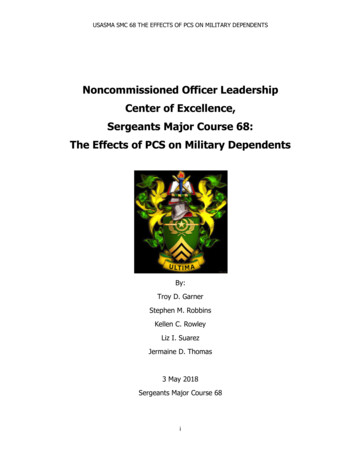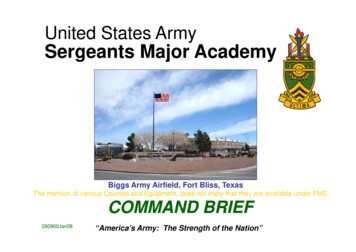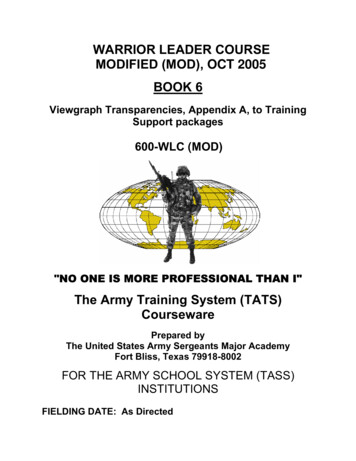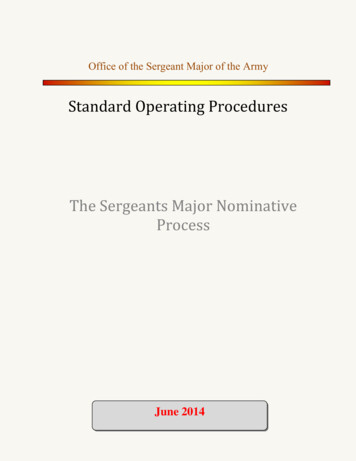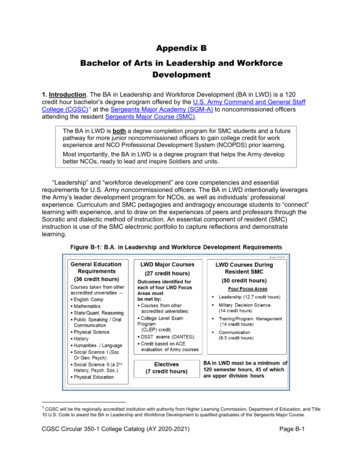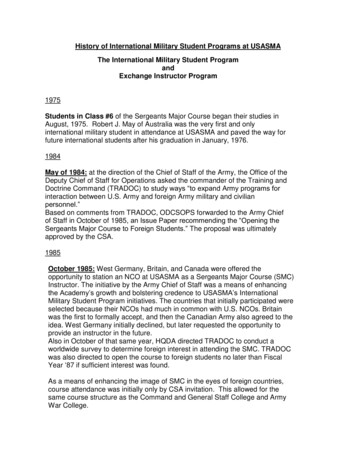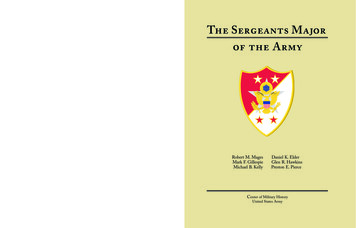
Transcription
The Sergeants Major of the ArmyCenter of Military History United States ArmyPIN : 073269–000The Sergeants Majorof the ArmyRobert M. MagesMark F. GillespieMichael B. KellyDaniel K. ElderGlen R. HawkinsPreston E. PierceCenter of Military HistoryUnited States Army
The Sergeants Majorof the ArmyRobert M. MagesMark F. GillespieMichael B. KellyDaniel K. ElderGlen R. HawkinsPreston E. PierceCenter of Military HistoryUnited States ArmyWashington, D.C., 2013
Library of Congress Cataloging-in-Publication DataMages, Robert M.The Sergeants Major of the Army / Robert M. Mages, Daniel K. Elder, Mark F.Gillespie, Glen R. Hawkins, Michael B. Kelly, Preston E. Pierce. — Revised edition.pages cmIncludes bibliographical references.1. United States. Army—Non-commissioned officers—History. 2. United States.Army—Non-commissioned officers—Biography. I. Title.UB408.5.S476 2013355.0092'273—dc232013014546First Printed 1995—CMH Pub 70–63–1
ForewordLast year, we said good-bye to William O.Wooldridge, our first Sergeant Major ofthe Army (SMA). I think it is fittingthat, as we write a new chapter in the Office ofthe Sergeant Major of the Army, we celebratethose who have come before us. Sergeant Majorof the Army Wooldridge was a pioneer, blazinga trail that thirteen of us have traveled. He wasinstrumental in the creation of this post, and wewill always remember his sacrifice and his contributions.The creation of the Office of the SergeantMajor of the Army in July 1966 represented amajor milestone in the development of the U.S.Army. For the first time in history, an enlistedsoldier assumed the role of adviser to the Chiefof Staff on all issues pertaining to the enlistedforce. Even after almost forty years, not muchhas changed. The Sergeant Major of the Armycontinues to advise the Chief of Staff on allenlisted matters, including quality of life andpay concerns.The establishment of the SMA position in1966 reflected the importance then of soldierrelated issues in the Army, and that emphasiscontinues today. I see myself as a scout for theChief of Staff and Secretary of the Army.My charge is to share with the enlisted corpsconcerns that are being worked on at the Armylevel and to bring back to the Pentagon mattersaffecting soldiers and their families.Offices and titles are essential in any largeinstitution, but ultimately people are the key toan organization’s success; the Office of theSergeant Major of the Army is no exception. Thenoncommissioned officers chosen to be SergeantsMajor of the Army have been individuals whonot only have had extraordinary careers, but whohave demonstrated exceptional dedication to thewelfare of their fellow soldiers. This commitmentmakes them truly effective advocates and spokesmen on enlisted-related issues.The careers and life stories of the men whohave served as Sergeants Major of the Army areboth inspirational and instructive becausethrough them we gain an appreciation for notjust the SMAs themselves, but for all the enlisted men and women who over the past two-anda-half centuries have worked, fought, and sacrificed to make the U.S. Army the finest militaryorganization in the world. As we continue totransform the Army to meet the challenges ofthe next twenty years, it is always appropriate tolook back and learn from our history.RAYMOND F. CHANDLER IIIFourteenth Sergeant Major of the Armyiii
PrefaceThe Sergeant Major of the Army (SMA)is the premier noncommissioned officer (NCO) of the United States Armyand serves as one of the nation’s senior soldiers.The office of Sergeant Major of the Army hasevolved into a position of great influence andresponsibility, largely as a result of the hardwork and exemplary service of the soldiers whohave occupied the post.The Sergeants Major of the Army is animportant volume in the official history of theUnited States Army. The first part of thisbook describes the origin and growth of theOffice of the Sergeant Major of the Army. Itexplains why some saw a need for such anoffice and tells who supported it in its infancy,who made it work, and why it has succeededas well as it has.The second part is a collection of biographical essays that document the personaland professional lives of the soldiers who haveoccupied this important post. Through thesesections, the reader gains insight into the character and motivations of the select group ofsoldiers who became the Sergeants Major ofthe Army. Many SMAs came from humbleorigins, joined the military to serve their country and see the world, and only graduallydecided to make the Army their career. Somefought the Germans in World War II. Otherssaw combat in such diverse locations as Korea,Vietnam, and the Persian Gulf. All experienced the joys and heartaches of being anordinary soldier, and over the years all weredeeply affected by the men and women withwhom they served. Each has used these lessonsto help shape the Army.This essay describes the family life andearly career of these exceptional soldiers andhighlights the events that molded their pointsof view and drove their desire to build a betterArmy. With this perspective in mind, the second half of each biographical chapter examinesthe achievements of each Sergeant Major ofthe Army. Lists of duty assignments and decorations are at the end of each chapter. In addition, further readings and an appendix thatoutlines the Presidents, Secretaries of theArmy, and Chiefs of Staff under whom therespective Sergeants Major served providescontext and framework.The history of the Sergeants Major of theArmy is more than just an account of bureaucratic institutions and the men that led them.It is also a story of the NCO Corps as a whole.The Army created the Office of the SergeantMajor in part because of important shifts inthe nature, structure, and responsibilities ofNCOs. During the course of their careers, theSMAs experienced these changes firsthand.They, in turn, helped shape the future of theNCO Corps.Finally, the history of the Sergeants Majorof the Army is a story of the Army itself. TheArmy has experienced extraordinary anddiverse challenges over the past half-century.Interspersed between repeated cycles of warand peace, mobilization and downsizing, havebeen such momentous developments as theend of the draft, the establishment of the volunteer Army, and the unrelenting advance oftechnology. Each Sergeant Major of the Armyfaced these and other potential barriers, as didthe dedicated corps of noncommissionedv
officers that makes the Army work. The cadre’s trials and triumphs underscore those ofthe entire Army. Thus this book gives today’ssoldiers a useful perspective from which toappreciate the past. This past undoubtedlywill shape the Army’s future, as the Armyonce again endeavors to transform itself intoan even more effective institution with whichto serve the American people in both peaceand war.ROBERT J. DALESSANDROChief of Military Historyvi
AcknowledgmentsThis book is the third edition of a U.S.Army Center of Military History(CMH) publication originally produced in 1995. Each edition adds anotherchapter to the proud history of the Office ofthe Sergeant Major of the Army. Severalpeople contributed to the writing of the 1995volume. Maj. Glen Hawkins wrote Part I,which recounts the history of the office.When Hawkins retired, Maj. Michael Kellytook on the project, coordinating interviewsand writing three of the biographical chapters. Upon Major Kelly’s retirement, Maj.Preston Pierce, an Individual MobilizationAugmentee, authored another three biographies. Finally, Maj. Mark Gillespie wrote twosections and guided the project to publication.Others outside the Center contributedgreatly to the first edition. Sgt. Maj. (Ret.)Erwin Koehler interviewed seven of the eightformer Sergeants Major of the Army for thebook. His questions form the basis of the individual essays. Sergeant Major of the ArmyWilliam O. Wooldridge’s section is a composite of an earlier interview and publishedremarks in various Army journals. BothSergeant Major of the Army Richard A. Kiddand Army Chief of Staff General Gordon R.Sullivan provided wholehearted support forthis project. Without their generous assistance,the first edition of this book could not havebeen published.A number of individuals deserve recognition for their important contributions to thebook’s second edition, published in 2003.Command Sergeant Major Daniel K. Elderrevised and expanded the volume, writing newchapters on the men who served as SMAsfrom 1995 to 2002. Dr. Andrew J. Birtle ofCMH provided valuable advice and assistanceduring the project’s research and writing.In 2011, I was assigned to revise and expandthe book, to include writing a new chapter onthe career of Sergeant Major of the ArmyKenneth O. Preston. Many people assisted mein this endeavor, a few of whom deserve specialmention. Stephen J. Lofgren, chief of CMH’sHistorical Support Branch, served as a patientadviser and editor. Dr. Robert D. Bouilly, thehistorian for the U.S. Army Sergeants MajorAcademy, provided much-needed researchmaterial. I am grateful to the Chief of MilitaryHistory, Robert J. Dalessandro; Chief HistorianDr. Richard W. Stewart; and Dr. Joel D.Meyerson, chief of the Histories Division at thetime, for entrusting me with this project. Also Iwant to acknowledge the individuals involved inthe production of this volume: Beth F.MacKenzie, chief of CMH’s Historical ProductsBranch; Diane Sedore Arms, editor; and GeneSnyder, graphic designer.ROBERT M. MAGESGeneral Editorvii
Preface to the First EditionThis history of the Sergeants Major ofthe Army fills a long-standing gap inthe history of the United States Army.The Army’s noncommissioned officer corps hasalways stood proudly in the front ranks to servethe nation in war and peace, in good times andbad. For too long, though, this selfless servicehas passed unnoticed. In one sense the lack ofrecognition of the NCO is a testimony to his orher professional dedication and sense of duty.The NCO was always there when needed. TheNCO always did what was needed. And theNCO was all too often taken for granted.The advent of high technology warfareplaced new demands on all ranks, perhaps nonemore so than NCOs. Not only did they have totrain soldiers, they had to learn along with theirsquads, platoons, companies, and battalions asthe U.S. Army adapted its doctrine and warfighting to meet the demands of the twentyfirst century. Yet many of the Sergeants Majorof the Army cut their teeth during World WarII. They served in Korea and Vietnam duringhot wars and everywhere from Germany toIndonesia during cold wars.Their stories are the centerpiece of thisbook. None enlisted or was drafted with thepromise of becoming a future Sergeant Major ofthe Army. None received special treatment.Some left the Army only to reenlist later.Others thought about leaving the Army. Buteach one of them made the Army his career andreached the top of his profession. Again andagain they credit an NCO who impressed themin basic training and became a role model forthem. They speak of the bygone massive Armyof World War II, of the Army at war in frozenviiiKorea and sweltering Vietnam, of the all-volunteer Army, of the garrison and post Army, butmost importantly they speak of, for, and to themen and women of the Army.The first part of this book describes the origin and growth of the Office of the SergeantMajor of the Army (OSMA). It explains whysomeone saw a need for such an office and tellswho supported it, who made it work, and why itsucceeded so well. Each Sergeant Major of theArmy made lasting contributions to the officeduring his tenure. The sections on individualSMAs uncover their motivations, goals, andaccomplishments. About half of each section is ageneral account of the respective Sergeant Major’sservice. The other half focuses on his role asSergeant Major of the Army. The insights andperspectives of the Sergeants Major of the Armycome from years of experience, training, professional development, and individual dedication tothe Army. At the end of each section is a chronological list of each SMA’s duty assignments. Theappendix to this book gives a table showing thePresidents, Secretaries of the Army, and Chiefsof Staff under whom the respective SergeantsMajor served.The project was initially beset by changingorganizational parameters and/or lack of authorcontinuity. However, in 1992 Col. Fred VanHorn, then commandant of the Sergeants MajorAcademy, approached Brig. Gen. Harold Nelson,the chief of military history at that time, aboutreviving the long dormant project. Since then,under the direction of professional historians,four officers share the credit for compiling andwriting this volume. Maj. Glen Hawkins beganthe work, organized the concept, and wrote the
section on the history of the OSMA. WithoutMajor Hawkins’ dedication and hard work, theproject might again have been delayed. WhenHawkins retired, Maj. Michael Kelly took overthe project. Major Kelly worked tirelessly tocoordinate interviews, administer various details,and write three of the essays. When Major Kellyretired, Maj. Preston Pierce, an individual mobilization augmentee, assumed the project andauthored another three sections. Finally, Maj.Mark Gillespie completed the book. He wrotetwo sections, interviewed Sgt. Maj. of the ArmyRichard A. Kidd, and saw the work through topublication. Each officer deserves much credit—had any one of them faltered, this book wouldnot have been published.Sgt. Maj. (Ret.) Erwin Koehler interviewedseven of the eight former Sergeants Major ofthe Army for this book. His questions form thebasis of the individual essays. Sergeant MajorWooldridge’s section is a composite of an earlierinterview and published remarks in variousArmy journals. Both Sergeant Major of theArmy Kidd and the Army Chief of Staff,General Gordon R. Sullivan, provided whole-hearted support for this project. Without theirgenerous assistance, this book could not havebeen published.A number of individuals at the U.S. ArmyCenter of Military History deserve recognitionfor their important contributions to this work.Dr. Jeffrey Clarke, chief historian, served as arigorous and exacting reader; John W. Elsberg,editor in chief, directed the publication of thisbook; Catherine A. Heerin and Diane M.Donovan edited the manuscript into its finalform; John Birmingham designed and electronically produced the pages; and Dr. LawrenceM. Kaplan of the Military Studies Branchhelped revise a number of draft chapters of themanuscript.This book tells the story of more than theSergeants Major of the Army. It tells about theNCO in the Army. It gives today’s soldiers andNCOs a perspective from the past on the Army’sfuture path. The views expressed in this publication are those of the respective Sergeants Majorof the Army and do not reflect the official policyor position of the Department of the Army, theDepartment of Defense, or the U.S. government.EDWARD J. DREAChief, Research andAnalysis Divisionix
ContentsPagePart I: The Office of the Sergeant Major of the Army . . . . . . . . . . .The Sergeant Major . . . . . . . . . . . . . . . . . . . . . . . . . . . . . . . . . . . . . . . . . . . . .Sergeant Major of the Army: Origins . . . . . . . . . . . . . . . . . . . . . . . . . . . . . . . .The First Sergeant Major of the Army . . . . . . . . . . . . . . . . . . . . . . . . . . . . . . .Confirmation . . . . . . . . . . . . . . . . . . . . . . . . . . . . . . . . . . . . . . . . . . . . . . . . . .Rebuilding a Corps . . . . . . . . . . . . . . . . . . . . . . . . . . . . . . . . . . . . . . . . . . . . .Stability and Growth . . . . . . . . . . . . . . . . . . . . . . . . . . . . . . . . . . . . . . . . . . . .Conclusion . . . . . . . . . . . . . . . . . . . . . . . . . . . . . . . . . . . . . . . . . . . . . . . . . . . .Part II: The Sergeants Major of the Army145714202844.55William O. Wooldridge . . . . . . . . . . . . . . . . . . . . . . . . . . . . . . . . . . . . . . . . . .George W. Dunaway . . . . . . . . . . . . . . . . . . . . . . . . . . . . . . . . . . . . . . . . . . . .Silas L. Copeland . . . . . . . . . . . . . . . . . . . . . . . . . . . . . . . . . . . . . . . . . . . . . . .Leon L. Van Autreve . . . . . . . . . . . . . . . . . . . . . . . . . . . . . . . . . . . . . . . . . . . .William G. Bainbridge . . . . . . . . . . . . . . . . . . . . . . . . . . . . . . . . . . . . . . . . . . .William A. Connelly . . . . . . . . . . . . . . . . . . . . . . . . . . . . . . . . . . . . . . . . . . . .Glen E. Morrell . . . . . . . . . . . . . . . . . . . . . . . . . . . . . . . . . . . . . . . . . . . . . . . .Julius W. Gates . . . . . . . . . . . . . . . . . . . . . . . . . . . . . . . . . . . . . . . . . . . . . . . . .Richard A. Kidd . . . . . . . . . . . . . . . . . . . . . . . . . . . . . . . . . . . . . . . . . . . . . . . .Gene C. McKinney . . . . . . . . . . . . . . . . . . . . . . . . . . . . . . . . . . . . . . . . . . . . .Robert E. Hall . . . . . . . . . . . . . . . . . . . . . . . . . . . . . . . . . . . . . . . . . . . . . . . . .Jack L. Tilley . . . . . . . . . . . . . . . . . . . . . . . . . . . . . . . . . . . . . . . . . . . . . . . . . .Kenneth O. Preston . . . . . . . . . . . . . . . . . . . . . . . . . . . . . . . . . . . . . . . . . . . . .57718597111123137151165179191207221Appendix: Chronological List of Presidents, Secretaries of the Army,Chiefs of Staff, and Sergeants Major of the Army . . . . . . . . . . . . . . . . . . . . . . 237Further Readings . . . . . . . . . . . . . . . . . . . . . . . . . . . . . . . . . . . . . . . . . . . . . . .IllustrationsSteuben at Valley Forge . . . . . . . . . . . . . . . . . . . . . . . . . . . . . . . . . . . . . . . . . . . .Office of the Sergeant Major of the Army at the Pentagon . . . . . . . . . . . . . . .General Harold K. Johnson . . . . . . . . . . . . . . . . . . . . . . . . . . . . . . . . . . . . . . .General Johnson Administers the Oath to William O. Wooldridge . . . . . . . . .2412368xi
PageBadge of the Sergeant Major of the Army . . . . . . . . . . . . . . . . . . . . . . . . . . . .Attendees of the First Command Sergeants Major Conference . . . . . . . . . . . .SMA Wooldridge and CSM Dunaway . . . . . . . . . . . . . . . . . . . . . . . . . . . . . . .Sergeants Major Academy . . . . . . . . . . . . . . . . . . . . . . . . . . . . . . . . . . . . . . . .General Sullivan Presents SMA Kidd the New SMA Insignia . . . . . . . . . . . . .CSM Jerry T. Alley. . . . . . . . . . . . . . . . . . . . . . . . . . . . . . . . . . . . . . . . . . . . . .CSM James C. McKinney . . . . . . . . . . . . . . . . . . . . . . . . . . . . . . . . . . . . . . . .General Reimer and SMA Hall with SMA Positional Colors . . . . . . . . . . . . .Eight of the Sergeants Major of the Army . . . . . . . . . . . . . . . . . . . . . . . . . . . .Sergeant Major of the Army William O. Wooldridge . . . . . . . . . . . . . . . . . . . .Private Wooldridge . . . . . . . . . . . . . . . . . . . . . . . . . . . . . . . . . . . . . . . . . . . . . .First Sergeant Wooldridge Relaxes with Fellow NCOs . . . . . . . . . . . . . . . . . .Wooldridge with Maj. Gen. Jonathan O. Seaman . . . . . . . . . . . . . . . . . . . . . . .Wooldridge with General Johnson . . . . . . . . . . . . . . . . . . . . . . . . . . . . . . . . . .Sergeant Major of the Army George W. Dunaway . . . . . . . . . . . . . . . . . . . . . .Dunaway with Troops . . . . . . . . . . . . . . . . . . . . . . . . . . . . . . . . . . . . . . . . . . .SMA Dunaway with Trainees at Fort Benning, Georgia . . . . . . . . . . . . . . . . .Dunaway Visits Hospitalized Soldiers . . . . . . . . . . . . . . . . . . . . . . . . . . . . . . .SMA Dunaway and President Richard M. Nixon . . . . . . . . . . . . . . . . . . . . . . .Sergeant Major of the Army Silas L. Copeland . . . . . . . . . . . . . . . . . . . . . . . .Copeland with Troops in Vietnam . . . . . . . . . . . . . . . . . . . . . . . . . . . . . . . . . .SMA Copeland Visits a Young Soldier . . . . . . . . . . . . . . . . . . . . . . . . . . . . . . .Mrs. Ann Copeland Visits an Army Hospital Patient . . . . . . . . . . . . . . . . . . . .SMA Copeland at His Retirement Ceremony . . . . . . . . . . . . . . . . . . . . . . . . .Sergeant Major of the Army Leon L. Van Autreve . . . . . . . . . . . . . . . . . . . . . .Van Autreve as a Young Soldier . . . . . . . . . . . . . . . . . . . . . . . . . . . . . . . . . . . .Van Autreve with Vietnamese Children . . . . . . . . . . . . . . . . . . . . . . . . . . . . . .Van Autreve Takes the Oath as Sergeant Major of the Army . . . . . . . . . . . . . .SMA Van Autreve at His Retirement Ceremony . . . . . . . . . . . . . . . . . . . . . . .Sergeant Major of the Army William G. Bainbridge . . . . . . . . . . . . . . . . . . . .Bainbridge at Flying School . . . . . . . . . . . . . . . . . . . . . . . . . . . . . . . . . . . . . . .Bainbridge as a Prisoner of War . . . . . . . . . . . . . . . . . . . . . . . . . . . . . . . . . . . .Bainbridge Rides an Elephant in Vietnam . . . . . . . . . . . . . . . . . . . . . . . . . . . .SMA Bainbridge and a Soldier During Exercise REFORGER . . . . . . . . . . . .Sergeant Major of the Army William A. Connelly . . . . . . . . . . . . . . . . . . . . . .Connelly Relaxes with Fellow NCOs . . . . . . . . . . . . . . . . . . . . . . . . . . . . . . . .Connelly on Duty in the Dominican Republic . . . . . . . . . . . . . . . . . . . . . . . . .First Sergeant Connelly in Vietnam . . . . . . . . . . . . . . . . . . . . . . . . . . . . . . . . .SMA Connelly Visits an Infantry Unit in Germany . . . . . . . . . . . . . . . . . . . . .Sergeant Major of the Army Glen E. Morrell . . . . . . . . . . . . . . . . . . . . . . . . .Morrell as a Young Soldier in Vietnam . . . . . . . . . . . . . . . . . . . . . . . . . . . . . . .Morrell at His Base Camp in Vietnam . . . . . . . . . . . . . . . . . . . . . . . . . . . . . . .SMA Morrell with General John A. Wickham, Jr. . . . . . . . . . . . . . . . . . . . . . .Morrell with Command Sergeants Major . . . . . . . . . . . . . . . . . . . . . . . . . . . . .Sergeant Major of the Army Julius W. Gates . . . . . . . . . . . . . . . . . . . . . . . . . 141144146150
PageGates with His Jump Equipment . . . . . . . . . . . . . . . . . . . . . . . . . . . . . . . . . . .CSM Gates in Germany . . . . . . . . . . . . . . . . . . . . . . . . . . . . . . . . . . . . . . . . .SMA Gates and General Carl E. Vuono with Troops in the Field . . . . . . . . . .Gates and Vuono with a Soviet Soldier . . . . . . . . . . . . . . . . . . . . . . . . . . . . . .Sergeant Major of the Army Richard A. Kidd . . . . . . . . . . . . . . . . . . . . . . . . .Kidd in Basic Training . . . . . . . . . . . . . . . . . . . . . . . . . . . . . . . . . . . . . . . . . . .Kidd with Other Young Soldiers Ready to Jump in Germany . . . . . . . . . . . . . .Kidd at a Temporary Base Camp in Vietnam . . . . . . . . . . . . . . . . . . . . . . . . . .Kidd as a First Sergeant in Korea . . . . . . . . . . . . . . . . . . . . . . . . . . . . . . . . . . .Sergeant Major of the Army Gene C. McKinney . . . . . . . . . . . . . . . . . . . . . . .Private McKinney in Vietnam . . . . . . . . . . . . . . . . . . . . . . . . . . . . . . . . . . . . .Sergeant McKinney with Sheridan Tanks . . . . . . . . . . . . . . . . . . . . . . . . . . . . .McKinney as 8th Infantry Division Command Sergeant Major . . . . . . . . . . . .SMA McKinney with Soldiers in Macedonia . . . . . . . . . . . . . . . . . . . . . . . . . .Sergeant Major of the Army Robert E. Hall . . . . . . . . . . . . . . . . . . . . . . . . . .Hall in Korea . . . . . . . . . . . . . . . . . . . . . . . . . . . . . . . . . . . . . . . . . . . . . . . . . .Staff Sergeant Hall . . . . . . . . . . . . . . . . . . . . . . . . . . . . . . . . . . . . . . . . . . . . . .CSM Hall During Desert Storm . . . . . . . . . . . . . . . . . . . . . . . . . . . . . . . . .SMA Hall in a Bunker in Bosnia . . . . . . . . . . . . . . . . . . . . . . . . . . . . . . . . . . .Sergeant Major of the Army Jack L. Tilley . . . . . . . . . . . . . . . . . . . . . . . . . . . .Private Tilley at Airborne School . . . . . . . . . . . . . . . . . . . . . . . . . . . . . . . . . . .Drill Sergeant Tilley. . . . . . . . . . . . . . . . . . . . . . . . . . . . . . . . . . . . . . . . . . . . .CSM Tilley and General William W. Crouch Awarding Medals . . . . . . . . . . .SMA Tilley in a Fox Vehicle . . . . . . . . . . . . . . . . . . . . . . . . . . . . . . . . . . . . . .Sergeant Major of the Army Kenneth O. Preston . . . . . . . . . . . . . . . . . . . . . . .Preston at Basic Training . . . . . . . . . . . . . . . . . . . . . . . . . . . . . . . . . . . . . . . . .Preston Receiving the Army Commendation Medal . . . . . . . . . . . . . . . . . . . .Preston in the Commander’s Cupola of His M60 Tank . . . . . . . . . . . . . . . . . .SMA Preston Addressing Members of Congress . . . . . . . . . . . . . . . . . . . . . . .SMA Preston and Sfc. Dale Green Prepare to Drive an M1A1Tank in Kuwait . . . . . . . . . . . . . . . . . . . . . . . . . . . . . . . . . . . . . . . . . . . . . .SMA Preston and Wife Karen During His Retirement Ceremony . . . . . . . . rations courtesy of the following sources: p. 2, Pennsylvania Capitol Preservation Committee; pp.3, 42, 212, 215, Off ice of the Sergeant Major of the Army; pp. 6, 58, 62, 65, William O. Wooldridge;pp. 8, 38, 178, 220, 230, 231, 232, Department of the Army; p. 12, U.S. Army Photographic Agency;p. 21, Michael’s Photography; pp. 208, 209, Jack L. Tilley; pp. 222, 224, 225, Kenneth O. Preston.All other illustrations are from the U.S. Army Sergeants Major Academy.xiii
Part IThe Off ice of the Sergeant Majorof the Army
Steuben at Valley Forge, Edwin Austin AbbeyThe sergeant major, being at the head of the non-commissioned officers, must pay the greatestattention to their conduct and behavior. He should be well acquainted with the discipline ofthe regiment, and the manner of keeping rosters and forming details. He must always attend theparade, be very expert in counting off the battalion and in every other business of the adjutant. —Friedrich W. A. von Steuben, Regulations for the Order and Discipline of theTroops of the United States, 1794
OSMAThe Off ice of theSergeant Major of the ArmyOne of the most important office locations in our nation’s capital is thePentagon’s “E Ring,” or outer hallway.There lie the offices of the most powerful civilian and military leaders in the defense establishment, as well as their key advisers and criticalsubordinates. The Sergeant Major of the Army(SMA) occupies Room 3E677, just across thehall from the Chief of Staff of the Army (CSA).Here, the Army’s top noncommissioned officer,with the assistance of a small personal staff, performs his duties and fulfills his responsibilities asa principal adviser to the CSA.The SMA is the chief ’s expert in all mattersconcerning the enlisted force. He is not only anombudsman for Army enlisted personnel but, asa member of various boards and committees, alsoOffice of the Sergeant Major of the Army at the Pentagondirectly influences policies whose effects ripplethroughout the Army. The SMA listens to thecomplaints and comments of enlisted men andwomen as someone who has been where they are,considers the impact of policy decisions fromtheir perspective, carries their views and voicestheir concerns to the decision makers in thePentagon, and focuses solely on their interestswithout being pulled or driven by other staffconsiderations. As such, he serves as a direct andpersonal communication line from the soldiers inthe field to the CSA and senior staff officers. TheSergeant Major of the Army’s job is to commenton the enlisted Army, carrying to the chief all thenews, good and bad, regarding the state of theenlisted force based on his experience.
For the noncommissioned officer corps, theSergeant Major of the Army also serves as a rolemodel for the youngest corporal as well as themost senior command sergeant major (CSM).Providing career inspiration by example, hemotivates soldiers to professional accomplishments and feats of excellence they might otherwise not achieve. The very existence of theOffice of the Sergeant Major of the Army(OSMA) supports and validates the position ofthe Noncommissioned Officer Corps as professional—worthy of special respect for commitment, expertise, dedication, and sacrifice in service to the nation.It seems natural, even logical, that we shouldhave an Office of the Sergeant Major of theArmy, as the pinnacle of achievement for a distinguished enlisted career, with a prestigious locationin the Pentagon and ready access to the seniorcommissioned officer of the Army. After all, thisposition reflects the situation at many lower levelsof command, beginning with battalions, wherethe sergeant major is the senior enlisted soldierwho serves and advises the organization commander in the myriad issues affecting enlistedsoldiers. Before 1966, however, the Army Staffhad not specifically designated anyone to represent the views of the enlisted Army. There was noone to visit soldiers worldwide, listen to what theyhad to say, and take the message back to the highest echelons of the Army Staff. No one directlypresented the enlisted perspective to the highestlevels of Army leadership. No one had as his orher primary duty the advocacy for the interestsand concerns of the enlisted ranks. Nor was thereanyone to act as a distinct, highly visible rolemodel to noncommissioned officers Army-wide.The establishment of the OSMA is rooted in thehistory of the NCO Corps, the rank of sergeantmajor, and the increasing professionalism withinthe Army over the years.The Sergea
the career of Sergeant Major of the Army Kenneth O. Preston. Many people assisted me in this endeavor, a few of whom deserve special mention. Stephen J. Lofgren, chief of CMH's Historical Support Branch, served as a patient adviser and editor. Dr. Robert D. Bouilly, the historian for the U.S. Army Sergeants Major


